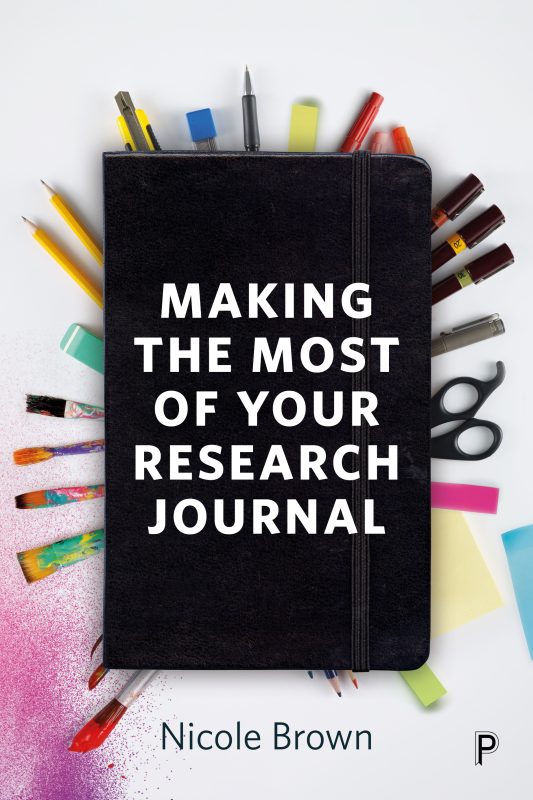
Source: PolicyPress
In my presentations and workshops I am often asked “What should I do with notes and journals?”. Now many people know that I have quite a collection, and so it is probably fair to ask me, specifically. In Making the Most of Your Research Journal I openly admit that I do not have one research journal:
At the time of writing, my physical ‘research journal’ is a collection of 12 different notebooks and pads as well as four ring binders, with each having its own particular purpose. For the sake of full disclosure: these notebooks and pads sit alongside electronic records on my desktop computer and 50-odd other physical versions that have been fully or partially completed, or entirely abandoned (Brown, 2021, p.11).
However, I also believe that the question is sometimes more of a rhetorical one highlighting anxiety and fear, but also worry around our notes and journals and the process of note-taking itself.
Of course, in this era of growing awareness of climate change and sustainability, there is a move towards not using paper. If we then decide – against our environmental sense – to use paper for note-taking, we may feel guilty of not making the most of the notes and journals. Also, we all have limited storage space, and if we were to keep every little shred of paper, we would soon drown in our notes and journals. Really, what shall we do with our notes and journals?
As always, and quite annoyingly, there is no one right way about dealing with pieces and piles of paper. So, here is what I do.
Notebooks and journals
I have notebooks and journals that I generally allocate to specific projects. Some of these notebooks and journals are fully completed, and others only partially filled. But generally, I keep these. Even when I finish a project, the relevant notebook or journal stays in a cupboard. At first, this was probably more to do with nostalgia than a scientific purpose. Over the years, though, I have grown more accustomed to the idea of revisiting notes and journals, and those old notebooks and journals, even those from completed projects, have proven useful. So, I wouldn’t throw these out.
Everyday notebook
I always have one A4 exercise book in use. That exercise book is lined and I work it from the front to the middle and from the back to the middle. One side is for meeting notes, the other side is for my to-do list. This is basically a way to keep notes from meetings, and all sorts of short-term, mid-term and long-term goals in one place. This everyday notebook organises my days and weeks. When an exercise book gets filled, I put it in my cupboard with all the other notebooks and journals. However, I do throw these everyday notebooks out, if I haven’t looked at them for a year or two. So basically, as I put one completed exercise book into my cupboard, I take an older one out to throw it away. Therefore, the pile of the everyday notebook never increases.
Journal articles and reading notes
This is where my habit has changed. During my studies, up to my PhD, I always printed what I wanted to read. Worrying that I may not have access to the article again, or not knowing what my thoughts were without my reading notes. This is why I started those binders. And I guess, during studies, it is quite alright to worry like that. After all, we don’t want to end up in a situation, where we may not have the notes and journals to fall back on. Technology could still fail us. Having said that, after the completion of a degree course, I always threw out all of the materials. I kept the binders, because I find them useful to show in presentations and workshops. But if I didn’t do that, I would have thrown those out ages ago, too.
How do you know what to throw and what to keep? And what if you make a mistake?
This is probably the most difficult part. And again, there is no easy answer. We honestly don’t know, can’t know. We just have to make choices:
The choices we are making as researchers relating to entries in a research journal are not dissimilar to holidaymakers on sightseeing tours. The person on vacation can consistently take dozens of photographs of the landmarks they see, literally from every angle and perspective; or they can decide to take one snapshot and enjoy the atmosphere, the sounds, the smells. The busy photographer may well have solid records of ‘what was seen’, but may not be able to recount ‘what it felt like’ to have been where they were (Brown, 2021, p.40).
In the end, what matters is that we don’t feel worked up or worried or guilty, whether this is about the journaling process or the getting-rid of the notes and journals. Instead, we just have to trust that we are doing what is right at a particular moment in time. Now for some, this may mean to begin hoarding all of the materials; for others, this may mean using the throwing-away as a therapeutic approach to exorcise the demons of a project that we finally completed. The important step in this is to learn to live with the consequences…
Reference:
Brown, N. (2021). Making the Most of Your Research Journal. Bristol: Policy Press.
Leave a message: